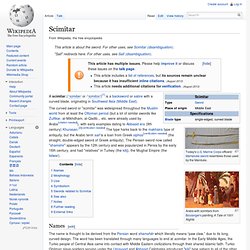

Flamberge.png (382×1024) Falchion.jpg (550×413) Schiavona-Morges.jpg (1600×1600) Espadon-Morges.jpg (341×1462) Scottish_claymore_replica_(Albion_Chieftain)2.jpg (5598×1470) Peter_finer_artfinding_german_twohanded_sword_12132791448819.jpg (2100×2100) 12b-katana.jpg (548×416) Dirk. Japanese WW2 naval dirk A dirk is a long thrusting dagger.[1] Historically, it was a personal weapon of officers engaged in naval hand-to-hand combat during the Age of Sail,[2] as well as the personal sidearm of the officers of Scottish Highland regiments,[1] and Japanese naval officers.[3] Etymology[edit] The term is associated with Scotland in the Early Modern Era, being attested from about 1600.

The term was spelled dork or dirk during the 17th century,[4] presumably from the Dutch, Swedish and Danish dolk, via German dolch, tolch from a West Slavic Tillich. The exact etymology is unclear; the sound change from -lk to -rk is rather common in Scots and Northern English loanwords from Danish (as in quirk, smirk from Danish kilche, smilke).[5][6][7][8][page needed] The modern spelling dirk is probably due to Samuel Johnson's 1755 Dictionary.
[edit] WWII era Soviet naval officers' dirks Highland dirk[edit] See also[edit] References[edit] External links[edit] Scimitar. Arabs with scimitars from Boulanger's painting A Tale of 1001 Nights A scimitar (/ˈsɪmɨtər/ or /ˈsɪmɨtɑr/)[1] is a backsword or sabre with a curved blade, originating in Southwest Asia (Middle East).

The curved sword or "scimitar" was widespread throughout the Muslim world from at least the Ottoman period (but a lot of similar swords like Zulfikar, al-Mikhdham, al-Qadib... etc. were already used by Arabs[citation needed]), with early examples dating to Abbasid era (9th century) Khurasan.[2][verification needed] The type harks back to the makhaira type of antiquity, but the Arabic term saif is a loan from Greek xiphos[verification needed] (the straight, double-edged sword of Greek antiquity).
The Persian sword now called "shamshir" appears by the 12th century and was popularized in Persia by the early 16th century, and had "relatives" in Turkey (the kilij), the Mughal Empire (the talwar). Names[edit] The following are regional terms for the scimitar: Morphology[edit] Use[edit] History of Roman swords. Roman swords History of Roman swords.

Roman gladius sword, Roman spatha sword and gladiator swords. Roman pugio dagger. Sword history. The Roman Sword or Gladius is one of the most widely recognized swords of any culture. Swords. Swords !!!

WEBSITE REBUILD UNDERWAY !!! "The history of the sword is the history of humanity. " Sir Richard F. Burton, 1884 The Sword There is nothing in the history of man that can compare with a sword. It is one thing to hold a hammer, another to hold a two-foot long pipe. Most of the swords made in current times are simply not real, but replicas heralding back to an earlier time or style.
Like my knives, with swords, I make the real thing. Back to Topics The word of God is living and active. --Hebrews 4:12 Replicas, Reproductions, Knock-offs, and Pop Swords The sword has always fascinated man, and plenty of different types of swords have been portrayed in humanity. What is the real thing, particularly when compared to what is available through mass marketing media and movie-licensed outlets?
Blade Steels: The real sword has a real blade, made of the highest quality modern tool steel available to man. Page Topics --John M. -Richard F. Considerations Before Ordering a Custom Sword Top of page.